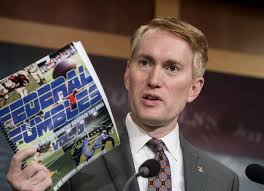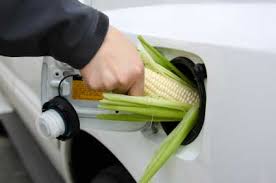
Sen. James Lankford, in his 4th edition of his Federal Fumbles report cites millions and millions of dollars in programs and grants that he considers to be wasteful government spending.
One of them is the Renewable Fuel Standard which he cited in earlier Federal Fumbles editions and this week said it is still unresolved. In the section dealing with RFS, the Senator said it is a problem created by Congress and “it is a problem only Congress can solve.”
Here is his explanation:
In 2005 Congress decided the US could not be energy
independent in the future, and we needed a way to
grow our own fuel. Congress also wanted to start using
a fuel that would reduce greenhouse gas emissions.
Corn-based ethanol was already blended into some
gasoline in the Midwest to increase the octane level, so
Congress determined that every state should now be
required to use ethanol in its gasoline. The mandate
for the amount of ethanol the US would use each year
was estimated (read: guessed) in order to determine
the amount of gas Americans would use in the future.
Then Congress set a gallon total for ethanol that Americans should use based on their estimate–not percentage amount used but a set number of gallons of ethanol that must be used each year. This process gave confidence to ethanol producers that if they could make the ethanol, Congress would require that Americans buy it.
The mandate required that corn ethanol would primarily be required for a decade, but after 10 years, more advanced fuel would be used derived from cellulose and less ethanol would be made from corn. Starting in 2005, ethanol was required to be blended into the fuel supply all over the country.
Initially 4 billion gallons were required in 2005, but by 2022
Congress required Americans to use 36 billion gallons
of ethanol. But there was a problem. Ethanol damages
pipelines, so it had to be trucked and blended closer
to its location of use. New infrastructure like storage
tanks and fuel pumps at every gas station would be
required to support higher ethanol-blend fuels. To help
with the transition, taxpayers footed the $100 million
bill for new blending-pump infrastructure all over the
US.

But it was all worth it because ethanol would
help us be energy independent, right? Well, not exactly. Within a few years, American geologists and engineers figured out how to produce oil from shale rock deep underground. That innovation
suddenly created an enormous new source of energy for the US, and it moved the US from an energy importer to an energy exporter within 10 years.
The US now produces nearly 12 million barrels of oil per
day, compared to approximately 5 million barrels per day in 2005. But ethanol reduces greenhouse gas emissions,
right?
Well, not exactly. The 2005 law grandfathered all the
existing ethanol facilities in the country. Every new
facility producing ethanol has to reduce greenhouse
gas emissions by at least 20 percent, but the existing
facilities do not have to reduce greenhouse gases at
all. That guaranteed existing producers would have
little to no competition for years because it costs too
much to build an ethanol facility that reduces emissions by 20 percent, and it would be almost impossible to compete with the existing grandfathered facilities.
Over a decade later, the vast majority of ethanol is
still produced only in the original grandfathered plants
that do not have to reduce greenhouse gas emissions.
So the ethanol mandate accomplished little to nothing
to reduce greenhouse gas emissions. Even worse, it has been discovered that using higher ethanol blends increases ground ozone levels, and corn-based ethanol uses a significant amount of water, which is also a precious natural resource.
Many environmental groups have moved from supporting ethanol years ago to strongly opposing it now. Federal mandates are really just federal preferences. Sometimes the mandates are notable or scientific, but they are all just preferences.

But corn-based ethanol is on the decline because the law required that corn ethanol use decrease and advanced (cellulosic) ethanol
increase over time, right?
Well, not exactly. Advanced ethanol by definition must
reduce greenhouse gas emissions by 40 percent. After
spending about $1.1 billion in taxpayer money from
2013 through 2015, which represent just three of
the previous 13 years in advanced cellulosic ethanol
research, we can produce small amounts, but it is not
economically viable for mass production.
Last year the US produced only 288 million gallons of cellulosic
ethanol, even though the law required that we use
7 billion gallons.As time goes on, the volume of
advanced fuels in the mandate grows relative to the
volume of the mandate that may be met by corn ethanol, so it will only get harder to have reality match the
greenhouse gas reductions envisioned by the statute.
But ethanol brings down the cost of fuel, right?
Well, not exactly. The EPA invented a new product to
trade on the open market years ago: Renewable Identification Numbers (RINs). RINs are paper certificates
that are created when you blend ethanol into gasoline.
So if you are a blender of ethanol, you create a paper
RIN when you mix ethanol with gasoline, but if you
are a distributor of gasoline you have to buy the paper
RIN to prove that America is selling the amount of
ethanol that the EPA requires. It is a complicated system devised by Congress over a decade ago.
When the RFS program began in 2005, RINs cost
only pennies each but over time the cost has risen
significantly. Someone has to pay for the RINs with
each gallon of gasoline. It is hard to track exactly how
much of the cost of each gallon of gasoline we buy
is attributable to compliance costs with the RFS, but
there is no question that the consumer pays more at
the pump because of this program. While we don’t
know the exact number, we do know that hundreds of
millions of dollars were traded in the RIN market last
year alone. This money changing hands does not add
value for consumers but rather represents some of the
cost to comply with a government program.
Ethanol is a good fuel for new cars and light trucks,
especially for increasing octane. After billions of
dollars in federal subsidies, it is firmly in the market,
and there is no question that it will stay a strong part
of our national fuel supply even without a mandate.
But most lawn mowers, boats, RVs, and older vehicles
should not use it. It is not better for the environment,
and it is not needed for energy independence.
EPA also ignores the gallons-used mandate with waivers
each year. You would think that Congress would just
respond by admitting the mistake, fixing the broken
law, and moving on. But you would be wrong. No one
is willing to admit that the ethanol emperor has no
clothes.
Dropping the mandate would mean new ethanol facilities could be built because they could compete with the grandfathered facilities. The cost of gas would decrease because blenders would no longer have to pay for the mandated RINs. They could just buy
the ethanol without absorbing the additional cost in paperwork. Research dollars could continue until we find an economical way to produce advanced fuel, but there is no reason to force Americans to spend more on gasoline than we need.
SOLUTION
As mentioned above, I have suggested several solutions to reform the RFS in previous volumes of Federal Fumbles. The cost of the RIN certificates has increased because the EPA set the mandates too high. But the EPA feels it must set the mandates high because the law 13 years ago set the minimum gallons high. Congress should eliminate the mandate entirely.
Congress should at least revisit the cellulosic and advanced fuel
requirements in light of the fact that the fuel still does not exist anywhere close to the amounts required under the law. At a minimum the volumetric mandate (total gallons used) should be replaced with a percentage mandate. Every time you fill up your tank with gasoline, you pay more for a federal mandate. Ethanol
is not the problem; the congressional mandate is the problem. This is a problem Congress created, and it is a problem only Congress can solve.






